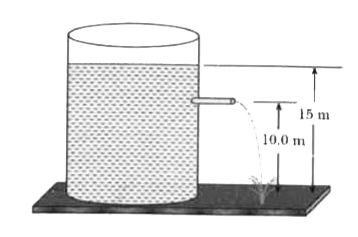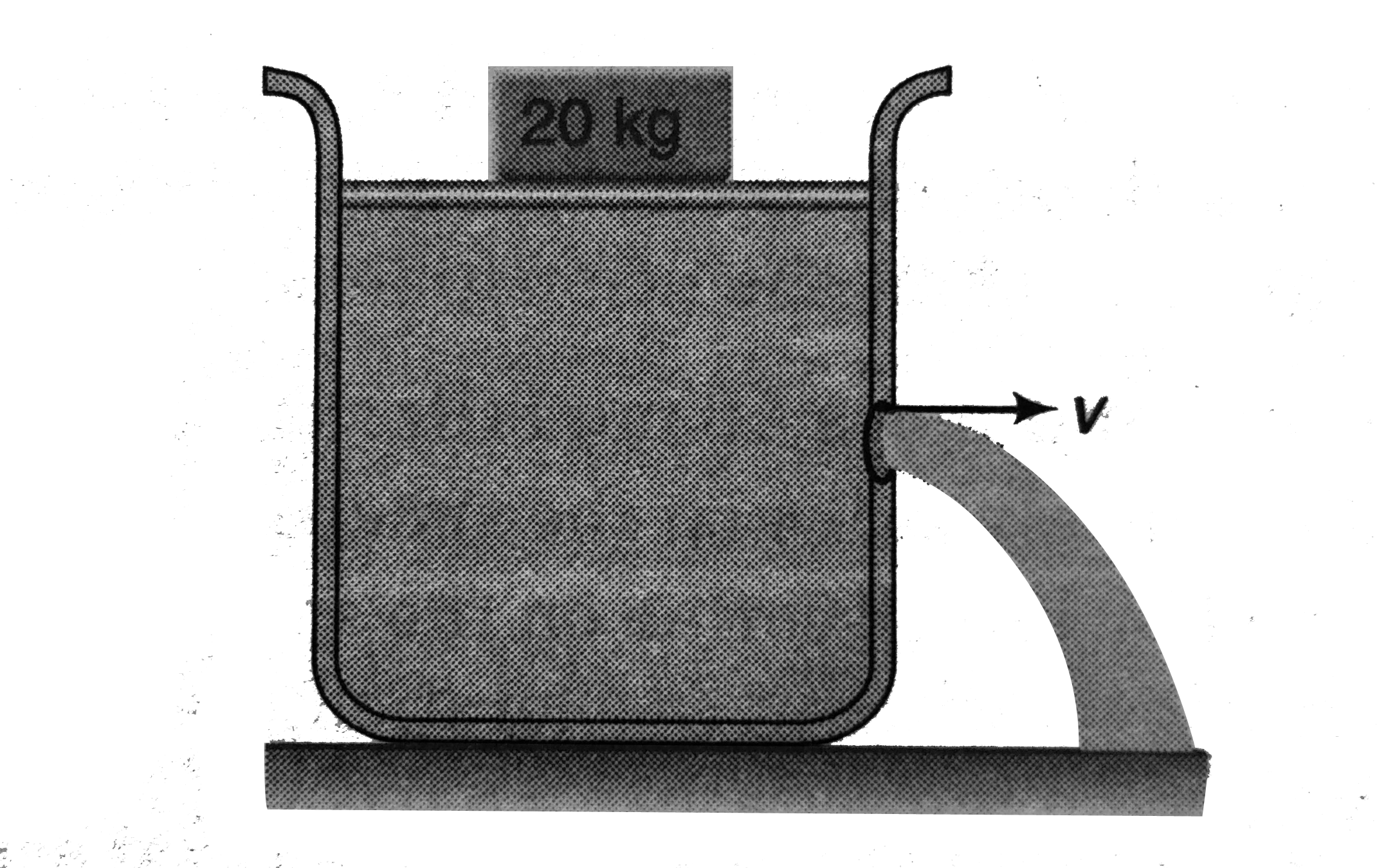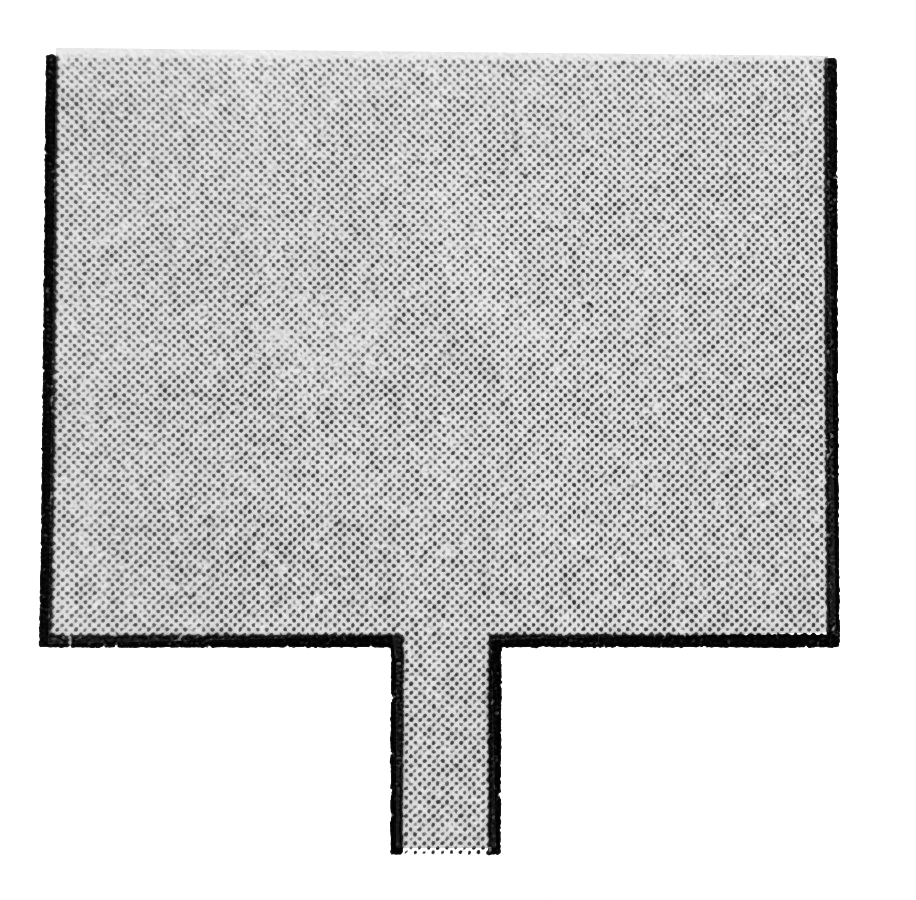A cylindrical tank with a large diameter is filled with water to a depth D =0.30 m. A hole of cross-sectional area A = 6.2 cm2 in the bottom of the tank allows water to drain out. (a) What is the drainage rate in cubic meters per second? (b) At what distance below the bottom of the tank is the cross-sectional area of the stream equal to one half the area of the hole?
To solve the problem step by step, we will break it down into two parts: (a) calculating the drainage rate in cubic meters per second, and (b) finding the distance below the bottom of the tank where the cross-sectional area of the stream is half the area of the hole.
Part (a): Calculate the drainage rate
1. Identify the given values:
- Depth of water, D=0.30m
- Cross-sectional area of the hole, A=6.2cm2=6.2×10−4m2
- Acceleration due to gravity, g=9.81m/s2
2. Use Torricelli's Law to find the velocity of water exiting the hole:
v=√2gD
Substitute the values:
v=√2×9.81m/s2×0.30m=√5.886≈2.43m/s
3. Calculate the drainage rate (Q):
The drainage rate is given by the product of the area of the hole and the velocity of the water:
Q=A⋅v
Substitute the values:
Q=6.2×10−4m2×2.43m/s≈1.51×10−3m3/s
Part (b): Find the distance where the cross-sectional area of the stream is half the area of the hole
1. Determine the new area:
The new area of the stream when it is half of the hole's area:
A′=A2=6.2×10−42=3.1×10−4m2
2. Use the principle of conservation of mass:
Since the product of area and velocity is constant:
A⋅v=A′⋅v′
Thus,
v′=A⋅vA′
Substitute the values:
v′=6.2×10−4⋅2.433.1×10−4=4.86m/s
3. Apply Bernoulli's equation:
Using Bernoulli's equation between the top of the water and the point where the area is half:
P1+ρgh1+12ρv21=P2+ρgh2+12ρv22
Since both points are open to the atmosphere, P1=P2, we can simplify:
ρgh1+12ρv21=ρgh2+12ρv22
Cancel ρ from the equation:
gh1+12v21=gh2+12v22
Rearranging gives:
g(h1−h2)=12(v22−v21)
4. Substituting known values:
Let h1=0.30m and v1=2.43m/s, v2=4.86m/s:
g(0.30−h2)=12((4.86)2−(2.43)2)
Calculate the right side:
(4.86)2≈23.58,(2.43)2≈5.90
Thus,
g(0.30−h2)=12(23.58−5.90)=12(17.68)≈8.84
Now substituting g=9.81:
9.81(0.30−h2)=8.84
Solving for h2:
0.30−h2=8.849.81≈0.90
Thus,
h2≈0.30−0.90=−0.60 (not possible)
Correctly, we should have:
h2=0.30−8.849.81≈0.30−0.90≈−0.60 (implying a mistake)
Instead, we should find the height difference:
h1−h2=8.849.81≈0.90⟹h2=0.30−0.90=0.90 (distance below the tank)
Final Answers:
(a) The drainage rate is approximately 1.51×10−3m3/s.
(b) The distance below the bottom of the tank where the cross-sectional area of the stream is half the area of the hole is approximately 0.90m.
- Depth of water, D=0.30m
- Cross-sectional area of the hole, A=6.2cm2=6.2×10−4m2
- Acceleration due to gravity, g=9.81m/s2
v=√2gD
Substitute the values:
v=√2×9.81m/s2×0.30m=√5.886≈2.43m/s
The drainage rate is given by the product of the area of the hole and the velocity of the water:
Q=A⋅v
Substitute the values:
Q=6.2×10−4m2×2.43m/s≈1.51×10−3m3/s
The new area of the stream when it is half of the hole's area:
A′=A2=6.2×10−42=3.1×10−4m2
Since the product of area and velocity is constant:
A⋅v=A′⋅v′
Thus,
v′=A⋅vA′
Substitute the values:
v′=6.2×10−4⋅2.433.1×10−4=4.86m/s
Using Bernoulli's equation between the top of the water and the point where the area is half:
P1+ρgh1+12ρv21=P2+ρgh2+12ρv22
Since both points are open to the atmosphere, P1=P2, we can simplify:
ρgh1+12ρv21=ρgh2+12ρv22
Cancel ρ from the equation:
gh1+12v21=gh2+12v22
Rearranging gives:
g(h1−h2)=12(v22−v21)
Let h1=0.30m and v1=2.43m/s, v2=4.86m/s:
g(0.30−h2)=12((4.86)2−(2.43)2)
Calculate the right side:
(4.86)2≈23.58,(2.43)2≈5.90
Thus,
g(0.30−h2)=12(23.58−5.90)=12(17.68)≈8.84
Now substituting g=9.81:
9.81(0.30−h2)=8.84
Solving for h2:
0.30−h2=8.849.81≈0.90
Thus,
h2≈0.30−0.90=−0.60 (not possible)
Correctly, we should have:
h2=0.30−8.849.81≈0.30−0.90≈−0.60 (implying a mistake)
Instead, we should find the height difference:
h1−h2=8.849.81≈0.90⟹h2=0.30−0.90=0.90 (distance below the tank)
(a) The drainage rate is approximately 1.51×10−3m3/s.
Topper's Solved these Questions
- BOOK - RESNICK AND HALLIDAYCHAPTER - FLUIDSEXERCISE - PRACTICE QUESTIONS (SINGLE CORRECT CHOICE TYPE)48videos
FLUIDS
- BOOK - RESNICK AND HALLIDAYCHAPTER - FLUIDSEXERCISE - PRACTICE QUESTIONS (More than One Correct Choice Type )10videos
FLUIDS
- BOOK - RESNICK AND HALLIDAYCHAPTER - FLUIDSEXERCISE - CHECKPOINT8videos
FLUIDS
- BOOK - RESNICK AND HALLIDAYCHAPTER - ELECTROMAGNETIC WAVES EXERCISE - PRACTICE QUESTIONS (Integer Type)3videos
ELECTROMAGNETIC WAVES
- BOOK - RESNICK AND HALLIDAYCHAPTER - FORCE AND MOTION - I EXERCISE - PRACTICE QUESTIONS (Integer Type)3videos
FORCE AND MOTION - I
Similar Questions
A cylindrical tank 7m in diameter, contains water to a depth of 4m. What is the total area of wetted surface
View SolutionA cylindrical tank of cross sectional area a1 is filled with water to a height h. A hole of cross sectional area a2 is made at the bottom. If a1=5a2, then find the
(i) initial velocity with which the water falls in tank.
(ii) initial velocity with which water emerges out from hole.
(iii) time taken to make the tank empty.View Solution
Knowledge Check
- Question 1 - Select One
A large tank is filled with water to a depth of 15 m . A spout located 10.0 m above the bottom of the tank is then opened as shown in the figure . With what speed will water emerge from the spout ?
 A3.1 m/sB9.9 m/sC14 m/sD17 m/s
A3.1 m/sB9.9 m/sC14 m/sD17 m/s - Question 2 - Select One
The level of water in a tank is 5 m high . A hole of the area 10cm2 is made in the bottom of the tank . The rate of leakage of water from the hole is
A10−2m3s−1B102m3s−1C10m3s−1D10−4m3s−1 - Question 3 - Select One
A large cylindrical tank has a hole of area A at its bottom. Water is oured in the tank by a tube of equal cross sectional area A ejecting water at the speed v.
Athe water level in the tank wil keep on rising.Bno water an be stored in the tankCthe water level will rise to a height v22g and then stopDthe water level will oscillate.
A long cylindrical tank of cross-sectional area 0.5m2 is filled with water. It has a small hole at a height 50cm from the bottom. A movable piston of cross-sectional area almost equal to 0.5m2 is fitted on the top of the tank such that it can slide in the tank freely. A load of 20kg is applied on the top of the water by piston, as shown in the figure. Calculate the speed of the water jet with which it hits the surface when piston is 1m above the bottom. (Ignore the mass of the piston)
 View Solution
View SolutionA tank of large base area is filled with water up to a height of 5m. A hole of 2cm2 cross section in the bottom allows the water to drain out in continuous streams. For this situation, mark out the correct statement(s) (take ρwater=1000kg/m3,g=10ms−12)
 View Solution
View SolutionA tank of height 5 m/s completely filled with water. There is a hole of cross sectional area 1cm2 near its bottom. What is the initial volume of water that will come out of the hole per second. (Use g=10m/s2)
View SolutionThe level of water in a tank is 5 m high. A hole of area of cross section 1 cm2 is made at the bottom of the tank. The rate of leakage of water for the hole in m3s−1 is (g=10ms−2)
View SolutionA cylindrical tank having cross-sectional area A is filled with water to a height of 2.0 m. A circular hole of corss-section area is opened at a height of 75 cm from the bottom. If a/A=√0.2, then velocity with which waer emerges from the hole is
(g=9.8ms−2)View Solution

